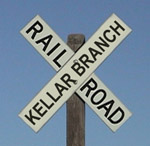 The Peoria Park District, City of Peoria, and the clandestine Kellar Branch Corridor Corporation have just about all their loose ends wrapped up to convert the Kellar Branch railroad to a hiking/biking trail. But there’s one more wrinkle left to iron out: reversion rights.
The Peoria Park District, City of Peoria, and the clandestine Kellar Branch Corridor Corporation have just about all their loose ends wrapped up to convert the Kellar Branch railroad to a hiking/biking trail. But there’s one more wrinkle left to iron out: reversion rights.
The land over which railroad tracks run is not always owned by the railroad operator or track owner. Rather, the corridor is often an easement on private property. The American Heritage Dictionary defines “easement” as “[a] right, such as a right of way, afforded a person to make limited use of another’s real property.” So in some places along the corridor, the city doesn’t actually own the land under the tracks, they just have the right to run the tracks over someone else’s property. That’s an easement. That means if the Kellar Branch ceases to be legally recognized as a railroad right-of-way, there’s a possibility that at least some of the right-of-way would revert back to the adjacent property owners. If that happened, then the corridor could not be turned into a trail unless all those pieces of the corridor were acquired through voluntary sale or eminent domain — likely at considerable cost.
There’s a way around this, though. It’s called “railbanking.” Railbanking is “preserving railroad rights-of-way for possible future use” (Wikipedia). Basically, if it’s railbanked, the corridor would continue to be treated as if it were still a rail corridor, even though it’s being used for other purposes. It preserves the corridor so that it could be returned to rail use in the future. It’s a legal sleight of hand maneuver in this case since the City and Park District clearly have no intention of ever reverting the corridor back to rail use under any circumstances. They just want to get railbanking designation so they can convert the right-of-way to a trail without having to pay owners of the underlying property for the use of their land.
According to the City’s latest filing with the Surface Transportation Board (STB), it sounds like this issue is a point of contention between the two parties. It will be interesting to see how the STB rules in the end. If they grant a discontinuance on the line, but don’t agree to railbank it, the process of converting the Kellar Branch to a trail will get a whole lot more complicated and expensive.
I’ll never understand why the City and Park District are so determined to turn this rail line into a trail. The amount of money, effort, time, blood, sweat, and tears spent on this project is disproportionate to its value, real or perceived. It’s become an irrational obsession, and naturally, it’s the taxpayers who will pay the ever-increasing price.

“I’ll never understand why the City and Park District are so determined to turn this rail line into a trail. The amount of money, effort, time, blood, sweat, and tears spent on this project is disproportionate to its value, real or perceived. It’s become an irrational obsession, and naturally, it’s the taxpayers who will pay the ever-increasing price.”
I will never understand irrational obsession to those that oppose the trail either.
Is there a map available showing exactly where the trail will be located, because I can’t find one. I seem to recall some of it going through Springdale cemetery to cross War Memorial instead of using the existing rail bridge. Is that true?
PeoriaIllinoisan,
At the link below, there’s a map on page 7 that shows the proposed path:
http://www.ritrail.org/documents/Kellar%20Alternatives%202.pdf
“I will never understand irrational obsession to those that oppose the trail either.”
If it stays a working rail line it doesn’t cost the taxpayers a dime and if fact could draw tax money back to the city hence the taxpayers.
Thanks, David.
What about that very expensive bridge over Knoxville?
The proposal before the Surface Transportation Board (STB) is to abandon the Kellar Branch on the south end of the Kellar Branch at Park Ave., but the link that David P. Jordan gave shows the hiking/biking trail not using any of the existing track until the opposite, north side of War Memorial Drive. For what purpose will the existing track right of way between Park and War Memorial be used? Also, with the trail going through Springdale Cemetery what changes will be made to the existing road in the cemetery and what kind of protection will be given to seperate hikers and bikers from vehicles in the tunnel under War Memorial? There are a number of graves north of War Memorial and around Memorial Day, nice weekends all spring, summer and early autumn there are many folks visiting graves. I can see real problems at the tunnel. In addition, will the hikers and bikers be given instructions to behave well in the cemetery and be respectful of the many elderly that must park near to gravesites located close to the road? This is a real concern to me as I often visit graves of relatives close to that road.
Any figures on use of one in morton ? Lombard [ Western suburb Chicago] has one ,i never saw any type of heavy use.
Popijw- I assume you’re talking about the Illinois Prairie Path? That is a very popular trail that’s been there for more than 3 decades.
The vast majority of trails are vacant 99% of the time. They’re like health club memberships. Everybody wants to have one, but hardly anyone uses them.